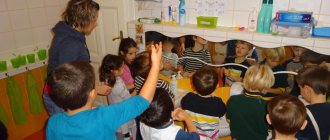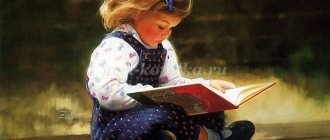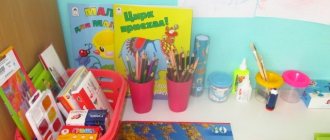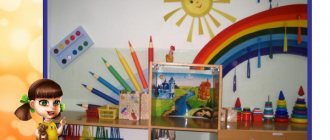"Centers for the development of children's creativity in the preschool group"
Consultation for teachers at preschool educational institutions “Centers for the development of children's creativity in the group of preschool educational institutions”
Author: Marina Vladimirovna Makarova, teacher, MADOU “Kindergarten No. 19 “Rucheyok”, city district. Gai, Orenburg region.
Creativity in the broad sense of the word is an activity aimed at obtaining something new and unique. The individuality of a preschooler is manifested in artistic creativity. In drawings, crafts, modeling, appliqué, and construction, children express their character, mood, and perception of the world around them. Organizing an appropriate developmental subject-spatial environment in a group helps to fully unleash the creative potential of each child. The implementation of the main educational program of preschool education provides, in accordance with the Federal State Educational Standard for Preschool Education, the creation of conditions that open up opportunities: for the positive socialization of the child; his personal development; developing initiative and creativity through collaboration with adults and peers and age-appropriate activities; creating a developing educational environment, which is a system of conditions for the socialization and individualization of children. The individuality of the individual is fully manifested in artistic creativity, through which each child expresses himself and realizes his abilities.
Artistic creativity in a preschool educational organization is part of educational work with children and bears the burden of solving problems primarily in the educational field of “artistic and aesthetic development.” An important role is played by a developing subject-spatial educational environment: centers for the development of children's creativity, creative workshops, corners of visual arts. The high-quality implementation of the tasks of the educational field “artistic and aesthetic development” is, in particular, facilitated by the creation of centers for the development of children's creativity in preschool groups. Their goal is to create an environment in the group for the creative activity of children, to promote the emergence and development of independent artistic activity in preschool children.
To create a developing subject-spatial environment of an arts center in a group, one should be guided by the following principles: Multifunctionality of the environment - the developing subject-spatial environment of the center should open up many opportunities, provide all components of the educational process, and in this sense should be multifunctional. Thus, the materials and equipment of the center can be used in the joint activities of adults and children, in the independent activities of children, not only within the framework of educational activities, but also during routine activities.
The transformability of the environment is the possibility of changes that allow, depending on the situation, to bring to the fore one or another function of space. For example, during a GCD, with the help of space markers, the appropriate equipment and materials of an art center can serve as a museum where children can tour the halls of painting, sculpture, or decorative arts. And after just a few minutes, with the help of space markers, this same center turns into a platform for role-playing games of artistic and creative content in children’s independent play activities. In the afternoon, children can study here using cards for individual work or engage in creative activities based on their interests.
In order for these centers to contribute to the creative activity of students and the development of their independent creative activity, it is important to comply with certain conditions for their design.
Thus, the center for the development of children's creativity is aesthetically designed, located in a place accessible to children with the opportunity for movement.
Taking into account the age characteristics of pupils of a particular group, a variety of visual materials are selected, as well as:
- materials for modeling, applique;
- development of color perception (palettes, cups for obtaining colored water, colored films, pieces of glass, educational games, etc.);
- compositional skills (educational and didactic material, didactic games); formation of graphic skills (rulers, stencils, spirograph rulers for different types of shading, didactic games, etc.);
- skills in using various techniques of fine art, including non-traditional ones (samples, algorithms for performing actions (image sequence diagrams)).
The content of children's independent visual activities is enriched by: wax, watercolor, pastel crayons, gel pens, markers, ink, charcoal, simple and colored pencils, felt-tip pens, erasers, sharpeners, watercolor paints, brushes of different sizes and hardness, water cans, coasters. brushes
In older groups, corners of artistic manual labor are created, where samples of fabrics, seams, hoops, colored threads, etc. are placed.
To familiarize preschoolers with folk arts and crafts, educational and didactic material and didactic games are used. Objects of folk arts and crafts are not mixed together. If, in the course of continuous educational activities, children become acquainted with the Dymkovo craft, then corresponding objects and illustrations are placed at the center of the development of children's creativity. In preparatory groups, it is allowed to place items from two crafts - something already familiar to children and something new. If a group has a large collection of decorative and applied arts, then a folk art museum is created.
Albums, illustrations, sets of postcards, reproductions, and didactic games are used to familiarize children with types of fine art (painting, decorative and applied arts, etc.), genres of painting (landscape, portrait, still life, everyday genre, battle painting). Albums are displayed on book stands in an unfolded form - this way they will attract the attention of preschoolers. It is not recommended to display all albums; it is better to select them depending on the topic being studied, holiday, etc.
The center of the development of children's creativity should be game attributes and a game character (especially in junior and middle groups), for example: a brush girl, pencil brothers, an artist's hat, a seven-flowered flower, etc.
Tables of various designs, easels, and hanging boards allow you to diversify the forms of organizing children’s independent visual activities in the center for the development of children’s creativity. Remember that the light on the work surface should fall from the left
One of the main indicators of a well-organized space is the presence of an exhibition of children's creativity. But this is not just drawings displayed for parents in the hallway, but a lighted place in a group where children independently place their works. Children's works are framed; drawings are not hung on an unframed wall.
A necessary element of a modern center for the development of children's creativity is technical teaching aids: audio and video equipment, electronic lessons on CDs.
It is important that the subject environment of the center has the character of an open, non-closed system, capable of adjustment and development. In other words, the environment should not only be developing, but also developing. Under any circumstances, the objective world surrounding the child must be replenished and updated, adapting to new formations of a certain age.
Taking into account the integration of educational areas - involves the use of material and equipment of this center in the implementation of other areas. For example, an art center necessarily contains color science games. It would seem that these games contain a highly specific focus, however, this is not the case. Color science games fit harmoniously into all educational areas and can be used in direct educational activities in various areas. They perform a whole range of developmental tasks that are so important for the formation of a preschooler’s personality. Color science games are aimed at developing fine motor skills of the hands, and at the formation of elementary mathematical concepts, and act as a means of cognitive activity for students.
Or, for example, a reproduction from the collection “Genres of Painting” can be used as visual material for the development of coherent speech. Taking into account gender specifics - involves providing the center environment with both general material and specific material for boys and girls. These can be collections of coloring books, stencils, templates, technological maps for the sequence of performing images and modeling, cards for individual work for boys and girls.
Taking into account the specifics of national and cultural conditions. When implementing the variable part of the program, the subject-development environment must quantitatively and qualitatively reflect the presence of priority areas, the specifics of national, cultural, demographic, socio-economic, climatic and other conditions for the implementation of the educational process. Translating this excerpt to the arts center, we can, first of all, pay attention to the design of this group zone using national cultural motifs (external design, selection of objects or illustrations of folk crafts, games and simulators based on patterns or crafts of the peoples of the region (Orenburg downy shawl ) informational, illustrated selection about the work of artists, sculptors, architects of their native land).
The materials and equipment of the center must create an optimally rich (without excessive abundance or lack) holistic environment.
Each group of preschool educational institutions creates its own center for the development of children's creativity, taking into account the age characteristics of the pupils and the implemented educational program of preschool education. The content of centers for the development of children's creativity must be periodically updated in accordance with modern requirements, as well as on the basis of studying advanced pedagogical experience in the artistic and aesthetic development of children.
Sources: 1. https://www.resobr.ru/article/59701-qqe-16-m7-detskoe-tvorchestvo-v-gruppe-dou
2.https://sadpavlovka.ru/konsultatsiya-dlya-vospitatelej/predmetno-razvivayushhaya-sreda-tsentra-iskusstv-v-gruppe
What is iso in kindergarten?
Visual arts are an excellent means of developing creative talents and all other abilities of a child. In addition, with the help of fine arts, children study the world around them. This is a specific figurative cognition of reality.
Interesting materials:
Why is mayonnaise harmful? What are the absolute indicators? What is the main purpose of communication? What is true female happiness? What is the difference between a monomer and a structural unit? What is the meaning of the play at the bottom? What is Hubble's law? What is Ohm's law for a section of a circuit? What are the main features of the hero of works of sentimentalism? What are the basic rules of telephone etiquette?



